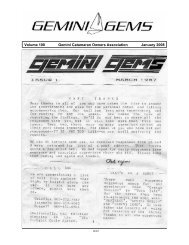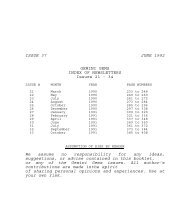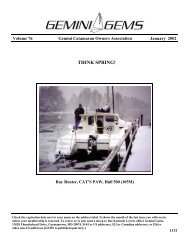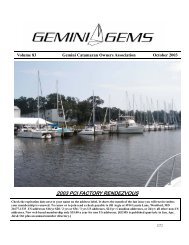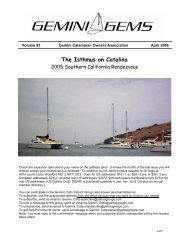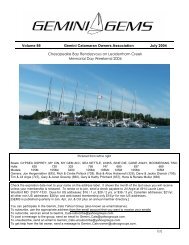Gemini Owners Manual.pub - Gemini Gems
Gemini Owners Manual.pub - Gemini Gems
Gemini Owners Manual.pub - Gemini Gems
Create successful ePaper yourself
Turn your PDF publications into a flip-book with our unique Google optimized e-Paper software.
<strong>Gemini</strong> 105Mc Owner’s <strong>Manual</strong><br />
How a Propane Refrigerator Works<br />
The continuous absorption type of a cooling unit is operated<br />
by the application of a limited amount of heat furnished<br />
by gas. No moving parts are employed. The unit<br />
consists of four parts: the boiler, condenser, evaporator<br />
and absorber.<br />
When the unit operates on propane, the heat is supplied<br />
by a burner which is fitted underneath the central tube<br />
(A) .<br />
How a Propane Refrigerator Works<br />
Heat is generated in the absorber by the process of absorption.<br />
This heat must be dissipated into the surrounding air.<br />
Heat must also be dissipated from the condenser in order to<br />
cool the ammonia vapor sufficiently for it to liquefy. Free air<br />
circulation is therefore necessary over the absorber and<br />
condenser.<br />
The whole unit operates by the heat applied to the boiler<br />
system and it is of paramount importance that this heat is<br />
kept within the necessary limits and is properly applied.<br />
The unit is charged consisting of a quantity of ammonia,<br />
water and hydrogen at a sufficient pressure to condense<br />
ammonia at the room temperature for which the unit is<br />
designed. When heat is supplied to the boiler system,<br />
bubbles of ammonia gas are produced which<br />
rise and carry with them, quantities of weak<br />
ammonia solution through the siphon pump<br />
- (C). This weak solution passes into the<br />
tube (D), while the ammonia vapor passes<br />
into the vapor pipe (E), and on to the water<br />
separator. Here any water vapor is condensed<br />
and runs back to the boiler system,<br />
leaving the dry ammonia vapor to pass to<br />
the condenser. Air circulating over the fins<br />
of the condenser removes heat from the<br />
ammonia vapor to cause it to condense to<br />
liquid ammonia from were it flows into the<br />
evaporator.<br />
The evaporator is supplied with hydrogen.<br />
The hydrogen passes across the surface of<br />
the ammonia and lowers the ammonia vapor<br />
pressure sufficiently to allow the liquid<br />
ammonia to evaporate. The evaporation of<br />
the ammonia extracts heat from the evaporator,<br />
which in turn extracts heat from the<br />
food storage space, as described above,<br />
thereby lowering the temperature inside<br />
the refrigerator.<br />
The mixture of ammonia and hydrogen vapor<br />
passes from the evaporator to the absorber.<br />
Entering the upper portion of the absorber is a continuous<br />
trickle of weak ammonia solution fed by gravity from the<br />
tube (D). This weak solution, flowing down through the<br />
absorber, comes in contact with the mixed ammonia and<br />
hydrogen gases which readily absorbs the ammonia from<br />
the mixture, leaving the hydrogen free to rise through the<br />
absorber coil and to return to the evaporator. The hydrogen<br />
thus circulates continuously between the absorber and<br />
the evaporator.<br />
The strong ammonia solution produced in the absorber<br />
flows down to the absorber vessel and from there to the<br />
boiler system, thus completing the cycle of operation.<br />
The liquid circulation of the unit is purely gravitational.<br />
Copyright © 2004 Performance Cruising Inc.<br />
53



